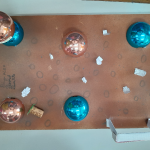Elcano Moon Camp by Elcano Moon Camp
IES Ciudad de Hércules Chiclana de la Frontera-Andalucía Spānija 15 gadi, 16 gadi 13 / 3 Angļu valodā Mēness
Projekta apraksts
Mūsu Mēness nometni mēs saucam par "Elcano", godinot spāņu jūrasbraucēju, kurš veica pirmo aplidošanu ap Zemi (16. gadsimtā).
At the lunar south pole, there are impact craters with permanently dark bottoms. We chose Shackleton Crater because its edges are exposed to light almost permanently, and its interior will provide us with frozen water and protection. Near the base, we will build the landing platform.
The camp (designed for 4 astronauts) will consist of connected semi-spherical modules with two exits:
- Central Module
- Kitchen/Dining/Gym/Common Room
- Rover Garage
- Workshop/Control Room
- Siltumnīca
- Laboratory/First Aid Room (experiments, microbial reactors, and medical robots)
- Bedrooms/Bathroom
- Hallways
The modules will be constructed by rovers with 3D printers. They will build a network infrastructure (using “cellular printing”) over inflatable domes, which will be filled with regolith. Interior walls and floors will be covered with BSC panels, composed of regolith and water bound by biopolymers (proteins manufactured by genetically designed microorganisms). Interior space separation panels and furniture will be constructed similarly.
The location and regolith constructions will protect astronauts from meteorites, extreme temperatures, and solar radiation. Hermetic hallways will prevent depressurization, in the case of a problem in any module.
We will also take care of their psychological well-being by projecting images of the Earth’s sky through artificial intelligence, changing the intensity and color of lights, emitting relaxing sounds, and also providing a robotic pet (dog). Moon proximity allows video conferences with loved ones on Earth.
In their daily routines, astronauts will dedicate 3 hours to exercise and 8 to base maintenance and research.
The camp will aim to be self-sufficient through greenhouses: LED lighting systems with specific wavelength lights will stimulate growth. We opt for aeroponic crops in rotating towers: they consume very little water, use space efficiently, and minimize the risk of pests. We will cultivate soybeans, potatoes, carrots, turnips, dwarf wheat, strawberries and tomatoes. We will continue researching more suitable genetically modified varieties. We will also cultivate hydroponics (watercress and algae). We will vary the diet with 3D food printers.
Robots with pressurized tanks will collect ice from the crater to liquefy it. We will also extract water from lunar regolith through filtration or distillation. Additionally, we will collect and purify water from urine and respiration through osmosis.
We will produce electricity through photovoltaic panels built with iron pyrite from the regolith installed on the crater’s edge: 0.4 hectares will generate about 100 kW. We will maximize their performance with heliostats. We will also produce electricity through radioisotope batteries and fuel cells (which directly convert H2 and O2 into electricity, water, and heat).
In habitable domes, we will create a breathable atmosphere. Plants and algae in the greenhouse will produce oxygen, utilizing CO2 from respiration and water from urine for photosynthesis. The iron and titanium from lunar soil can catalyze water electrolysis extracted from the regolith itself, producing oxygen, hydrogen, and methane from solar radiation and exhaled CO2.
Astronaut feces will be anaerobically decomposed by microorganisms. Methane obtained through this process would allow us to cultivate Methylococcus in reactors and produce biomass rich in proteins and fats (edible for astronauts or for insects that we may raise in future). Further research is needed for menstrual waste.
Regarding spacesuits, we will need to collect waste and investigate solutions that facilitate multi-day expeditions away from the base.
Projekta saite
https://drive.google.com/file/d/1CNqcgVLZH6_Wkvg8kS46jWInA4WjsL61/view?usp=drive_link
Projekta video
#
3D dizains
Citi projekti
Draudzības galaktika MOON Base




















